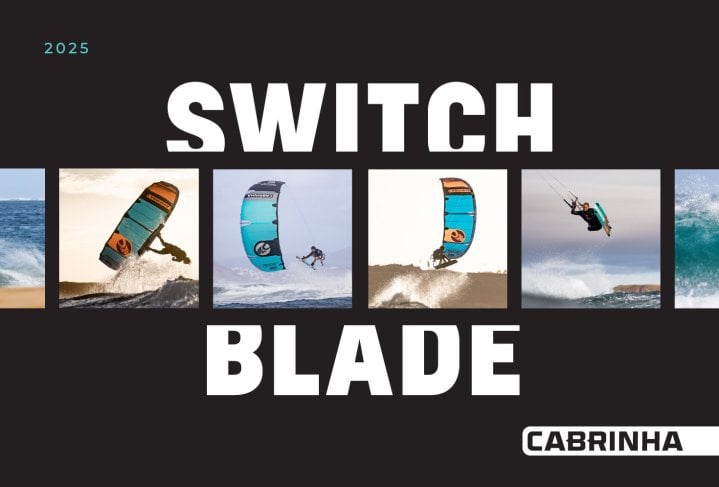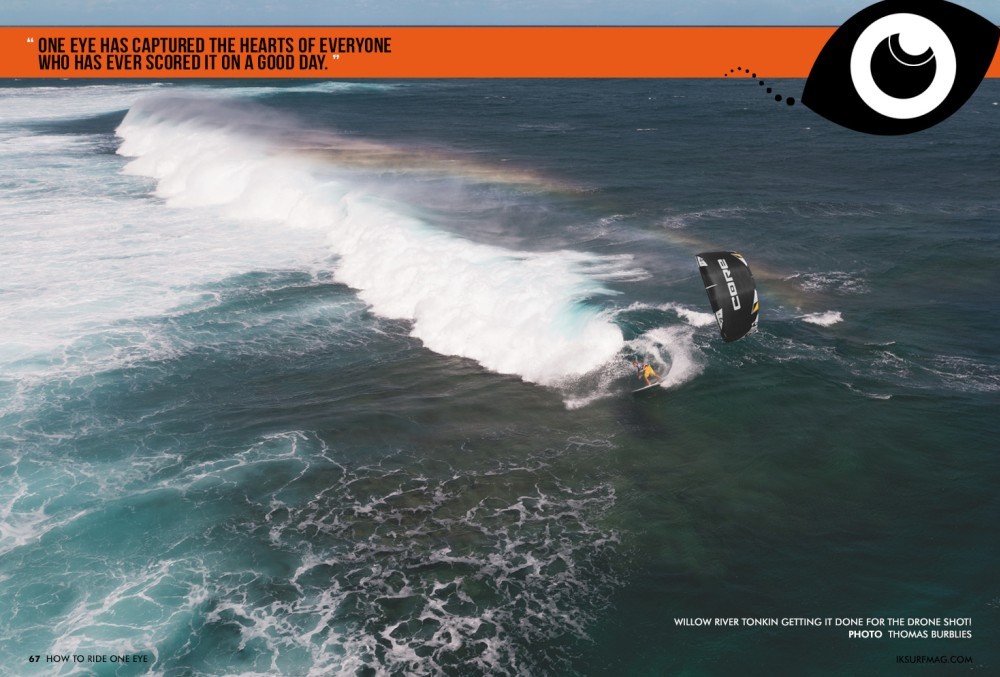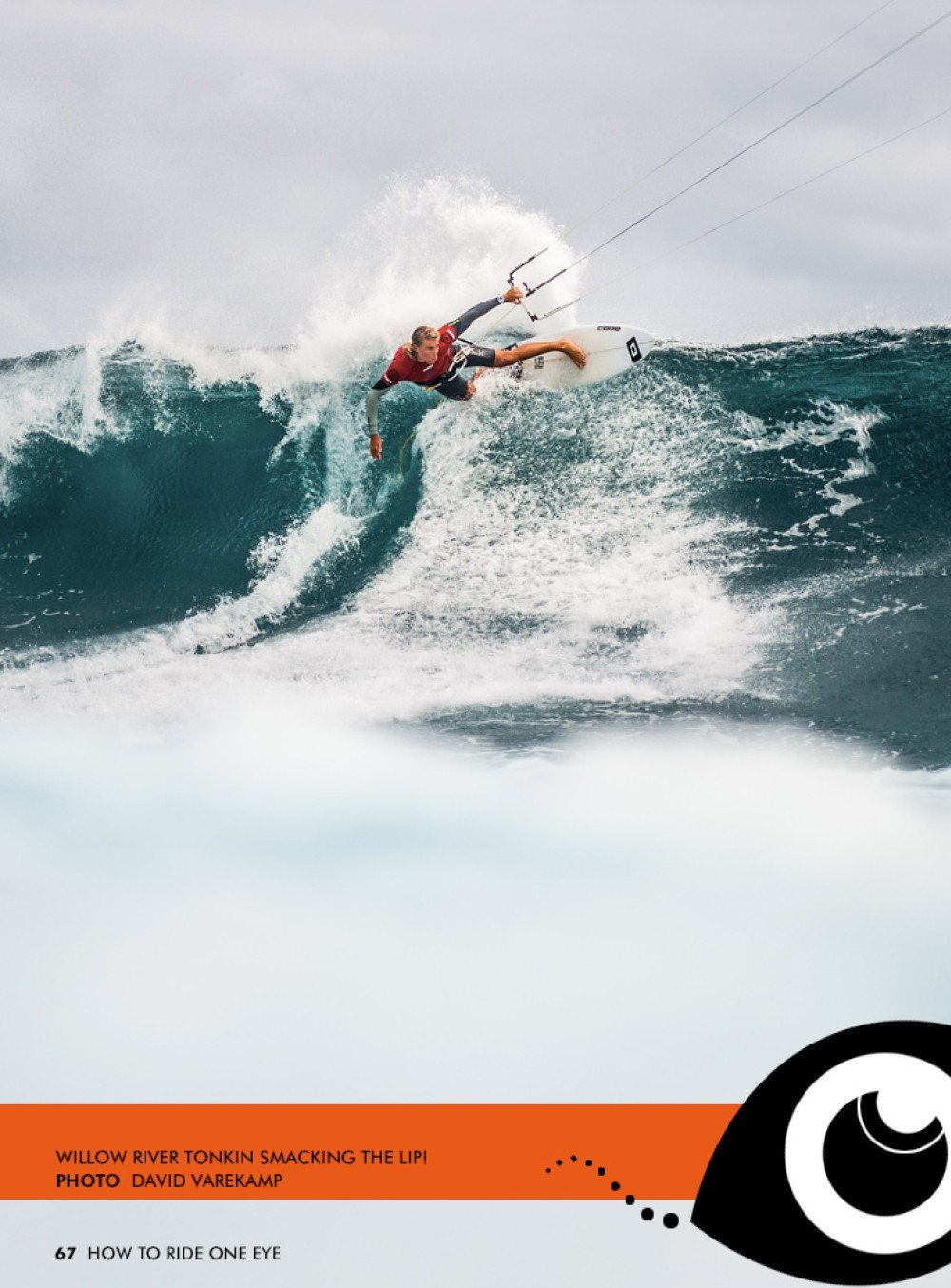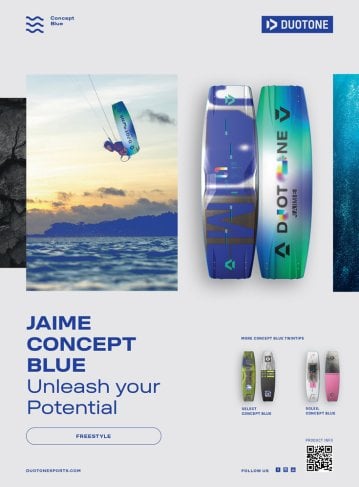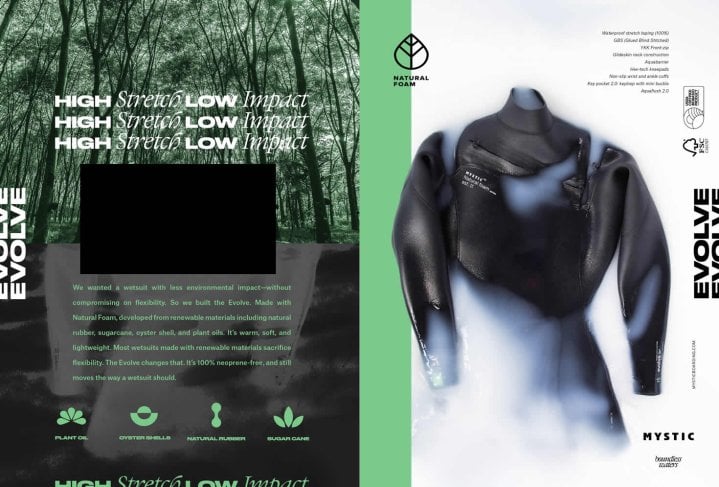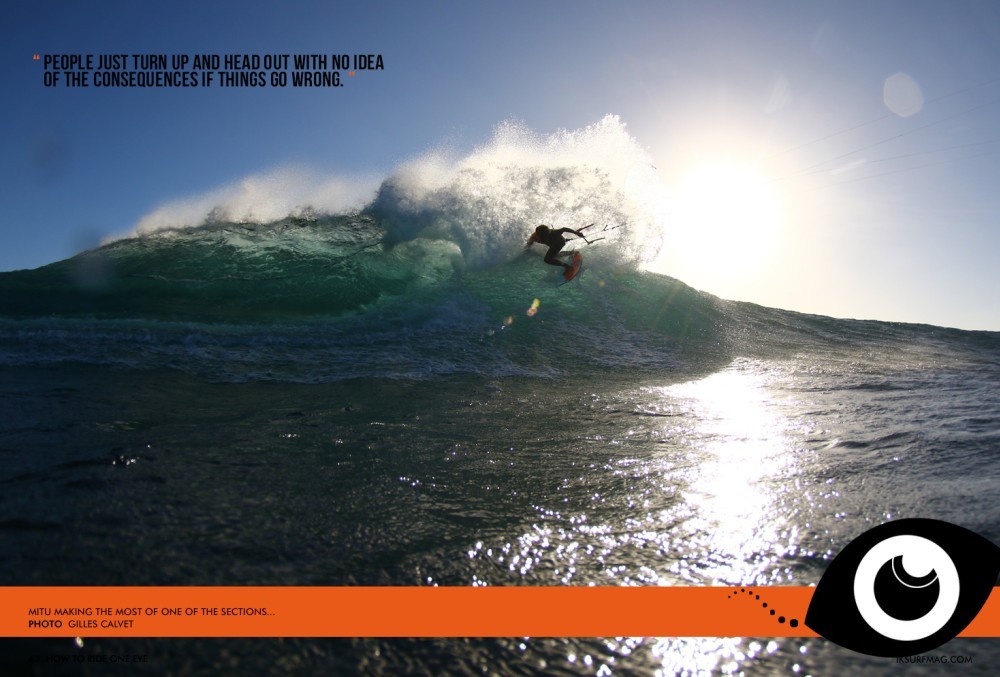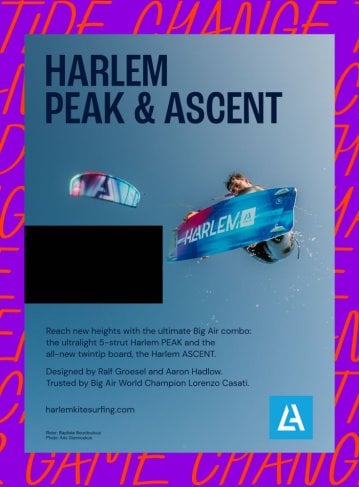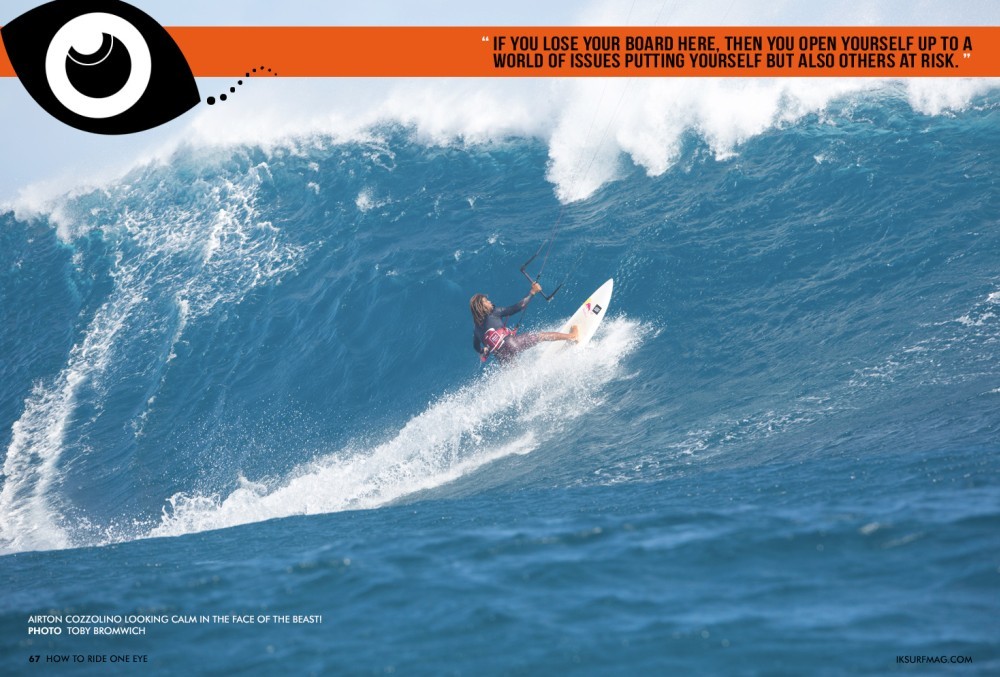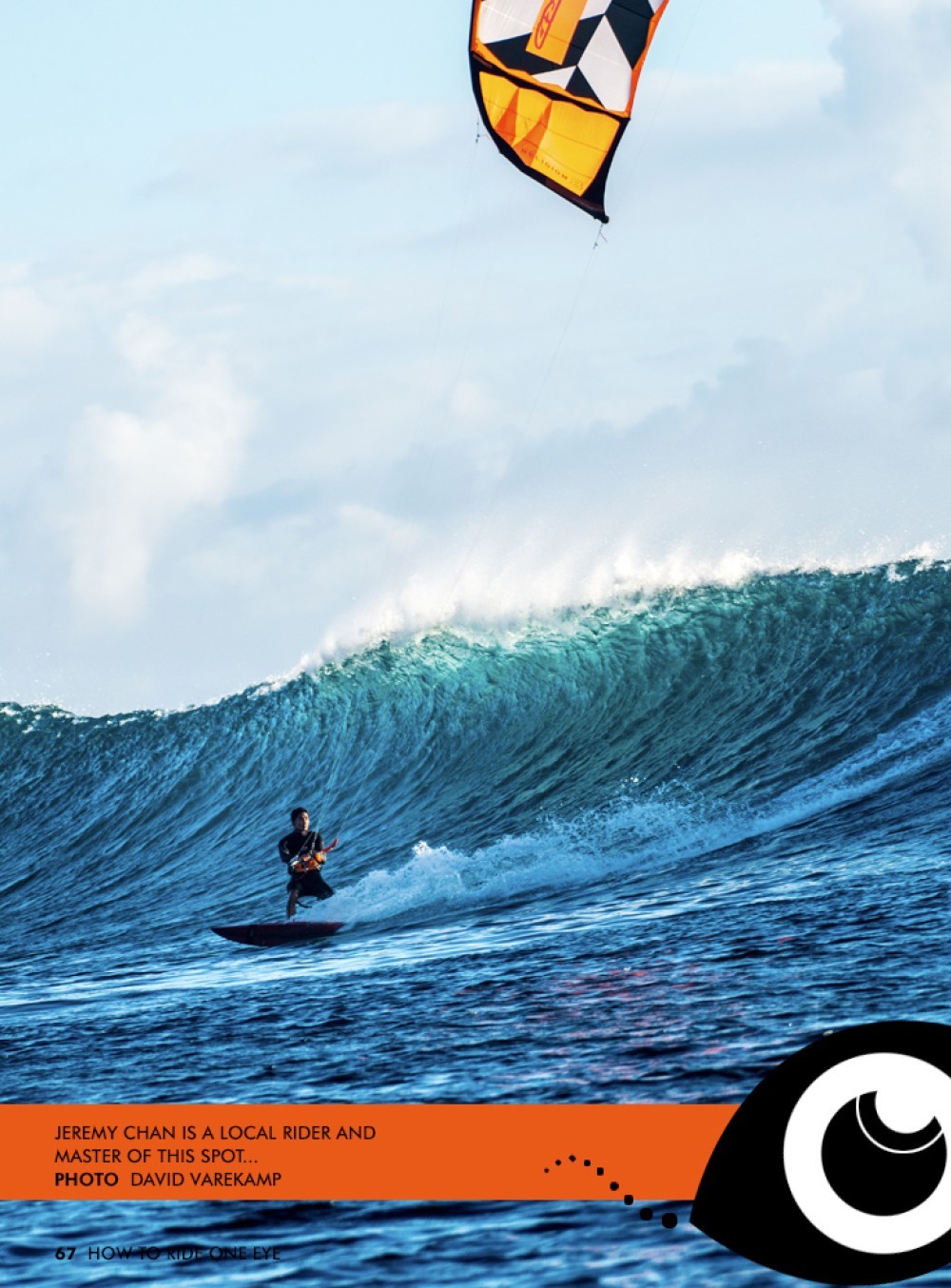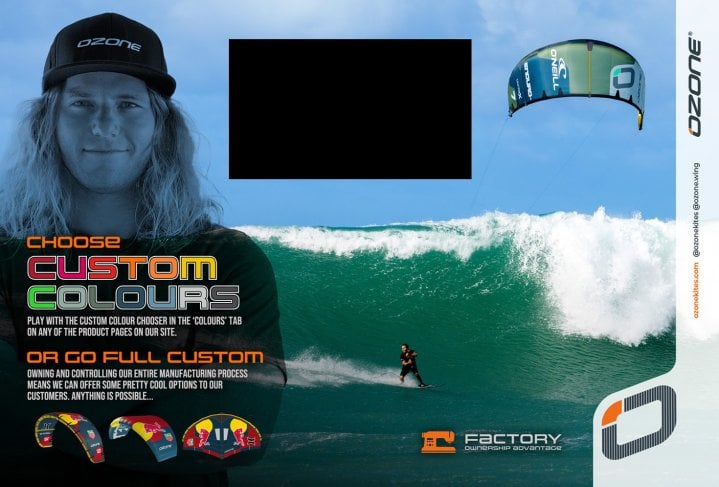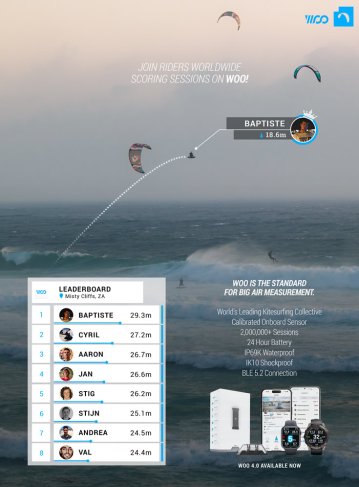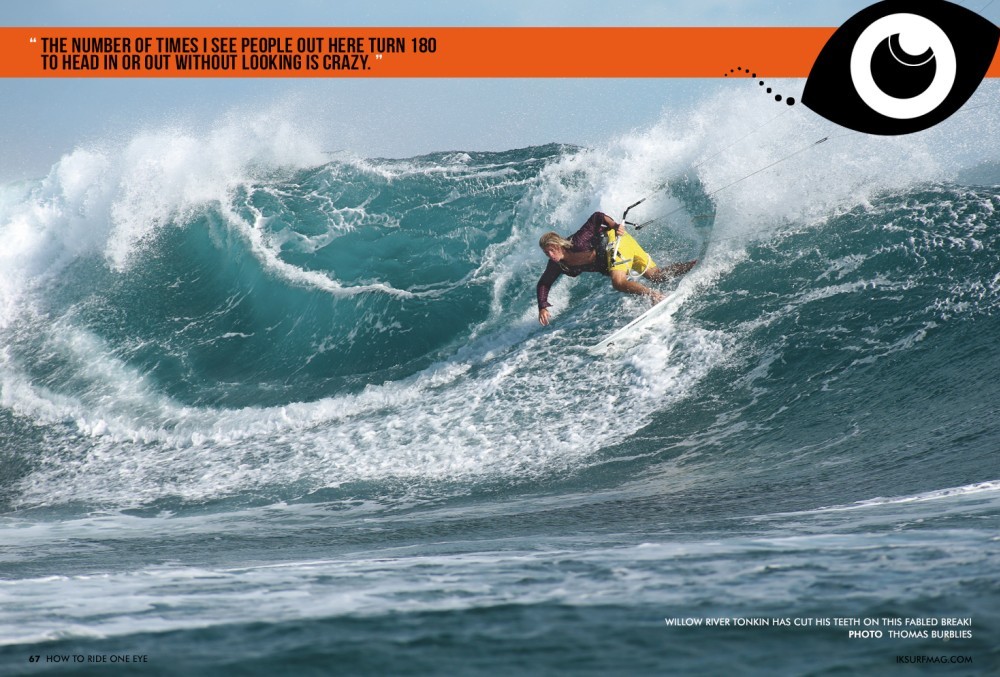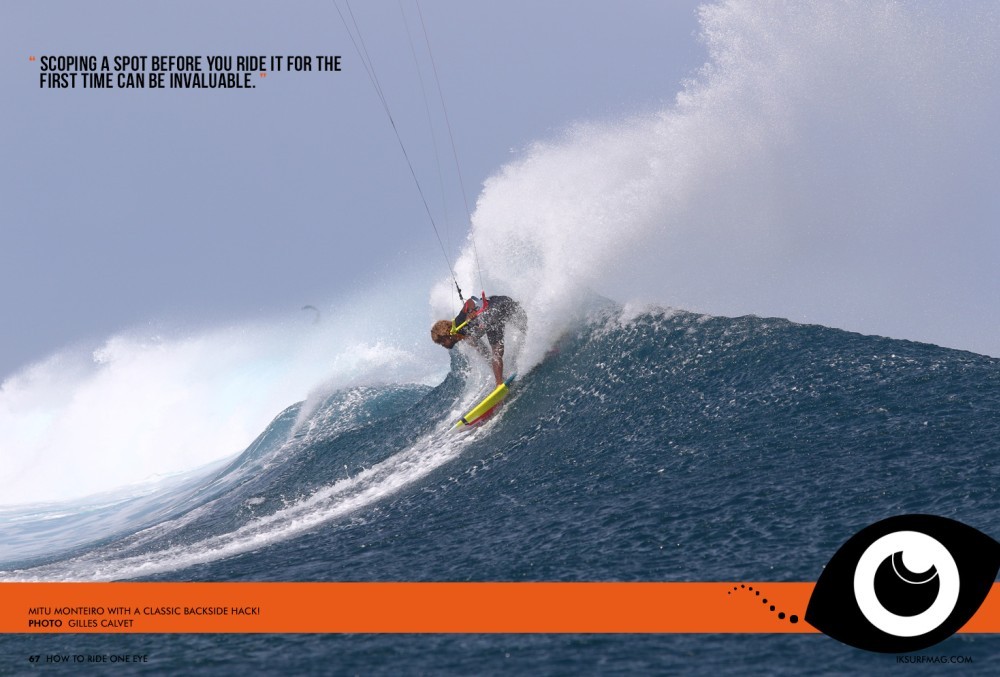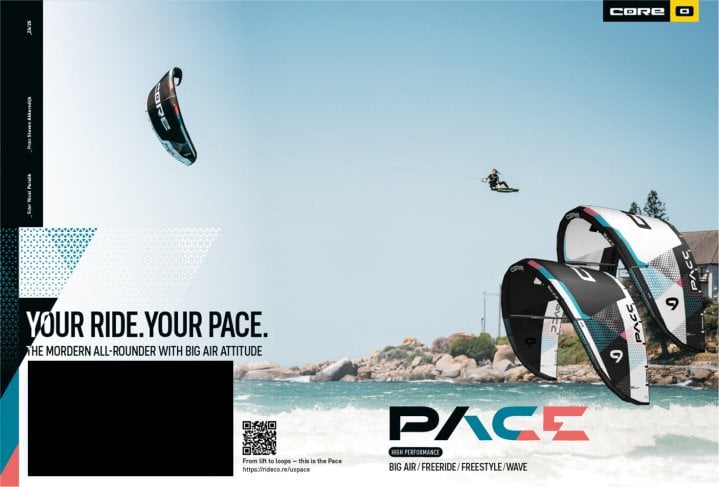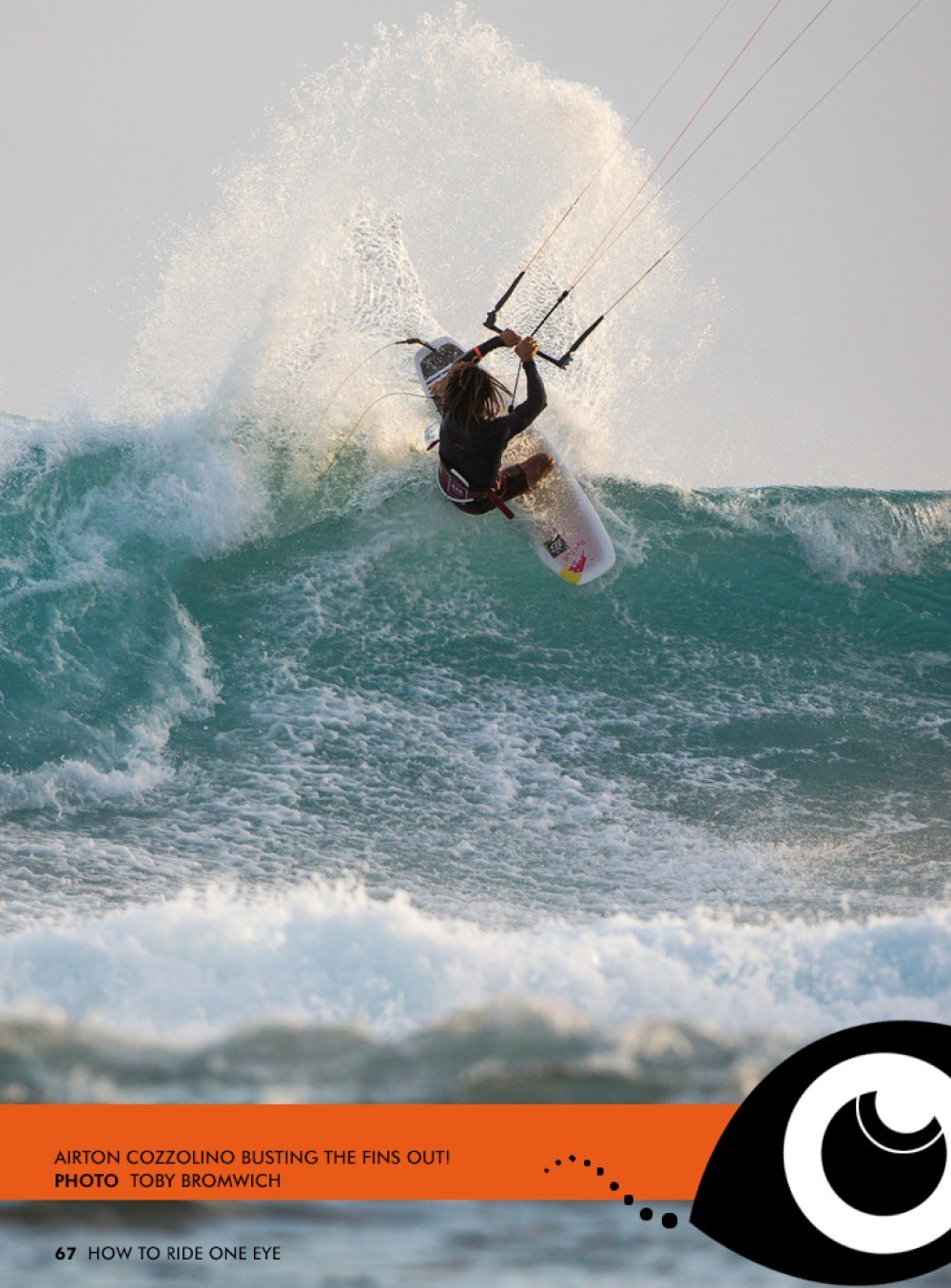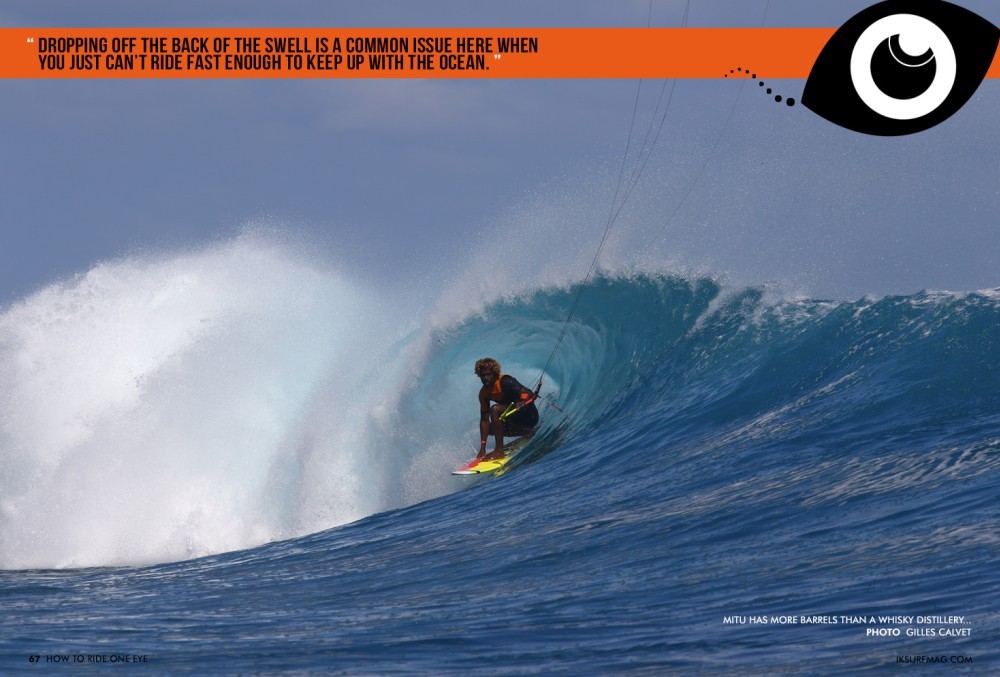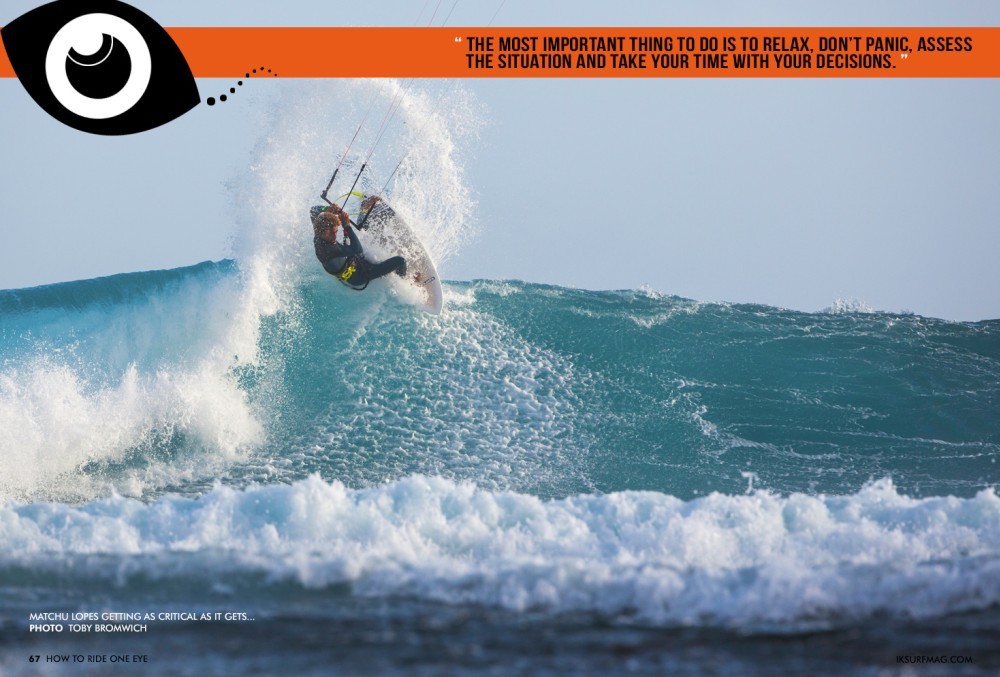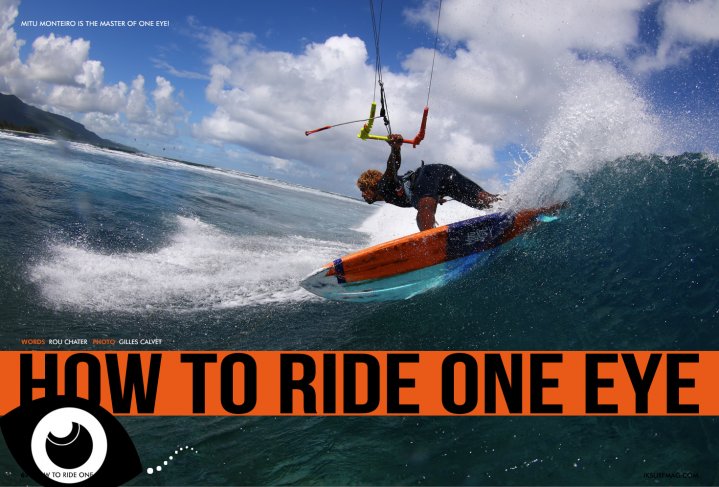
How To: Ride One Eye
Issue 67 / Thu 8th Feb, 2018
Rou Chater has been travelling to One Eye in Mauritius since before it was even a thing, in the old days it was quiet and menacing, these days it’s a zoo out there. If you’ve ever wanted to know the best way to tackle it, and how to survive then read this!
If there is one wave that has featured on more covers, in more videos and sits at the pinnacle of most riders ambitions, it is the fabled One Eye in Mauritius.
Ever since the aerial shots by RRD featured on the cover of many a magazine back in 2005, the place had been put firmly on the kitesurfing map. Found on the island of Mauritius off the coast of an area known as Le Morne, One Eye has captured the hearts of everyone who has ever scored it on a good day.
It’s a rocket ship left-hander reef break, served by a cross offshore prevailing wind that sits about 500m off the beach. When you are stood on the public beach looking at the beast on a big day, it’s a sight to behold. It reels seemingly endlessly when it’s perfect and travels at warp speed.
Le Morne is a spot that needs no introduction, we’ve covered it numerous times, and personally, I rate it as one of the best locations for kitesurfing on the planet. In a 2 mile radius, you have a beach that is perfect for beginners with onshore winds and shallow flat water. The lagoon is ideal for bump and jump riding with a small reef offering an excellent introduction to wave riding. Then further out to sea, the marauding Manawa delivers a sometimes huge, yet safe place to play in bigger waves.
On the other side of the channel sits the infamous One Eye. Sadly the fact that Le Morne is so perfect means it is now pretty busy too. With most brands visiting en masse at some point in the year and holiday companies running trips with up to 30 riders at a time it can be a real zoo out there. Especially on the smaller days when the spot is decidedly safer than when it rears its head.
Safety is a key word when talking about One Eye. It’s no secret that people sadly die here. A campaign to allow a jetski rescue service is underway; personal watercraft are banned on the island, no doubt in a bid to stop holidaymakers blasting around the bays and spoiling the tranquillity. However, if ever a spot deserved to have a proper rescue service it is One Eye.
The “underwater waterfall’ you often see in aerial images is the effect of thousands of tons of water pushing into the lagoon from big swells with only one exit point. The main channel at Le Morne. This creates a river of water that runs directly out to sea and into the Indian Ocean. Next stop is arguably Australia if you are lucky.
The danger factor is increased as once you are behind the waves and outside of the lagoon, you are invisible to those on shore. You can’t be seen if your kite is down and so you need to rely on the kindness of strangers, or indeed your mates to alert the limited rescue cover on offer. On a big day the rescue boats can’t even get out to you as the channel closes out, so then my friend you are really on your own.
Safety is paramount here, and it amazes me just how little information there is about the dangers on the public beach. People just turn up and head out with no idea of the consequences if things go wrong. If you’re sensible, you can ask a local for some advice, if you're lucky you are coming with a friend who can talk you through it. To venture out at One Eye without understanding the risks and dangers is as foolhardy as putting a 12m up in a force nine gale and relying on the “100% depower” the brand boasted about on the website.
Before you even think about riding here, you should be an exceedingly confident swimmer and happy swimming in huge waves. If things go wrong, the current is such that you might find yourself swimming for hours on end if you are stuck on the outside. If you get washed over the reef, then you’ll have to contend with a severe rinsing over razor-sharp coral.
If you crash your kite on a decent sized day, there is a good chance it won’t survive. I’ve seen so many people head back to the beach in pieces; lost kite bars are common as the lines wrap around the coral, trapping the kite and delivering it a beating in the impact zone that it was never intended for. You can usually cut the lines and salvage the kite, but the bar and lines will be toast if they spend too long down there.
Another safety consideration is a leash; I often get asked why I ride with a surfboard leash on my board. One Eye is a classic example of a spot where you can’t ride without one. If you lose your board here, then you open yourself up to a world of issues putting yourself but also others at risk. Having a leash means that when the inevitable happens, and you get a pasting from a massive lip you can at least body drag out of there.
You might feel like you’ve been put through traction, your board leash will probably be three or four foot longer for the experience, but you will be able to quickly gather your senses and get the hell out of there before the next onslaught. Without a leash, you’ll be body dragging through the impact zone getting in the way of other riders chasing after a rogue board that is headed all the way to the inside of the lagoon.
It’s also imperative that you have a solid understanding of the rights of way when wave riding. If you don’t, please don’t head out there. You’ll just join the other riders dropping in and ruining waves and spoiling what should be a magic time for everyone.
On a smaller day here you will see the very worst that kitesurfing has to offer. I hate to say it, but it’s true. Small days make the place reasonably safe and easy to ride. It will be insanely busy, and everyone and their dog will be trying to stake a claim to riding One Eye. I’ve seen some of the worst infringements during these days, know the rules and be prepared to call people out on drop-ins and wave stealing.
When it gets bigger is when the magic happens. Anything over 6 foot is chunky here and as the size increases the ability of the riders increases by default. This means experienced guys with an awareness of the other riders around them. The number of times I see people out here turn 180 to head in or out without looking is crazy. Crashing one kite is a nightmare you don’t want to visit, crashing two is unthinkable.
This is the sort of place where you have to be aware not only of yourself but of everyone around you too, anticipate, if you can, what they are likely to do. If you see someone turn without looking, call them out and avoid them like the plague in future. Always look before you gybe or tack and even when you are on the wave be aware of the guy on the wave in front and the wave behind and how your riding and decisions will affect them.
To say this isn’t a place for the novice is an understatement, yet sadly still they come. Why? Because in all honesty, this wave is easy to ride. The reef, swell and wind line up perfectly to enable you to drop in as deep as you wish. The shoulder is a safe place to be, and you can quickly turn face and get the hell out of there with the wind and reef angle as they are as soon as things get a little spicy.
What’s the best way to approach One Eye?
Firstly be armed with information, know the wind forecast and the swell forecast, is it stable for the day? Will the swell jump up later on; is the wind forecast to drop off? Another important thing to be aware of is the tide. At low tide the reef is dry, and I mean dry. It can be six inches above the waterline on a low spring tide, literally leaving you between a rock and a hard place should you get caught on the inside!
The next thing to do is sit and watch; take a look at the guys already out there. Study the waves, look where they are closing out, where they are running and where the barrel section is. Spending an hour or two scoping a spot before you ride it for the first time can be invaluable. Even more so if you start to visualise yourself out there, picture yourself on the wave and think about where your escape routes are and what your action plan will be should things go wrong.
Those last two paragraphs are the Seven P’s - "prior preparation and planning prevent piss poor performance". Never underestimate the value of knowledge and how going into a situation prepared can be far more beneficial than charging into the line up with no real action plan.
The next decision you need to make is how to get out there. There are two routes to One Eye. The first is to ride out the channel to the right of Manawa, hug the reef at Chameaux and then drop in at the top end of One Eye. This is by far the easiest option; it is also the long way around. Personally, I prefer it in most situations. It puts you right in the spot without ever having to deal with any oncoming waves, unless it’s a huge day and the channel is closing out. Even then it’s still a safer bet.
The other route is to head out through the waves at One Eye. There is a channel in the reef that you can use. However, it is worth noting that this is further down to the right as you look at the wave and the wind here can be gusty and fickle. If the tide is in, then you can make a break for it over the reef and right into the white water and the waves. This is the highest risk approach and should be reserved for the pro’s and more experienced riders only.
The direct route only works at high tides. Otherwise, you’ll risk losing your fins before you even get a wave, or worse still running aground and wrecking your board… You should be able to see what the tide is doing from the beach, watch the other riders and spot the best place to tackle this launch technique. It’s not for the faint of heart.
If you’ve taken the easy route out through the channel, you’ll now be positioned high up on the reef and ready to take on the wave. If you’re regular you’ll be riding backside, this place is a goofy footers dream. The swell in the Indian Ocean moves fast, and getting into a wave at One Eye on a big day requires you to ride at Mach 10 to and keep up with the swell before it slows as it hits the reef.
Dropping off the back of the swell is a common issue here when you just can’t ride fast enough to keep up with the ocean. The other problem is that it is pretty choppy too, so you’ll need to be flexing your knees as the board bounces around and clinging on with your toenails. You might find straps make it a lot easier for your first foray out there, we won’t judge you!
All that’s left to do now is decide how deep you want to go; it’s easy to be a shoulder warrior and hug the end of the wave rather than get deep. This is an excellent way to familiarise yourself with the spot, then as confidence builds just drop in a little deeper and deeper. As you get deeper, you’ll need to watch out for the closeout sections.
Here you have a few options, drop over the back of the wave before the wave closes out. Tuck in for the barrel if you are feeling ballsy, although the closeouts aren’t the best place for this and are usually a recipe for disaster. Or try and outrun the section and head towards the reef.
This last option is only really open at higher states of the tide, and of course, each situation is different depending on the size of the swell and the conditions of the day. Dropping off the back is usually the best option, however, be aware of who’s on the wave behind and where they are, sometimes you might be forced to stay in front and navigate your way over the reef if there is no clear exit behind.
The epic barrel shots here are all taken in the same spot, so while you might think you can get in and out of the barrel at any point on this wave, the easiest place to do it is at the end section just before the small channel that the boats use.
What to do if it goes wrong?
The easiest thing to do is to NEVER, EVER, drop your kite. In ten years and countless sessions at this spot with a couple of near-death experiences, the worst situations are always when you drop your kite. I’ve only done it a couple of times and each time was in my early career here. These days at all costs I try and keep the kite in the sky, it’s a lifeline that you really need.
If you do drop it, you need to make a decision based on the conditions of the day, but don’t be afraid to ditch the kite and surf in. Your kite is worth less than your life, and the chances are it will be trashed pretty quickly anyway. On small days it isn’t so bad, but on a big day, there is a solid chance of being dragged underwater for longer than you may care.
Again it comes down to preparation, being physically fit, being comfortable in big waves, taking waves on the head and holding your breath. If you do get into a tricky position, the most important thing to do is to relax, don’t panic, assess the situation and take your time with your decisions.
I’ve been lucky enough to have been coming here since 2005; It’s an almost annual pilgrimage that delivers every time it is on. These days I prefer the larger days as there are fewer people, but the small ones can be fun too. If you wave ride, then this spot should be on your bucket list.
Ridden properly, it’s a fantastic spot to challenge yourself and push your wave riding further. Just remember that it has a darker side too, it will punish you if you aren’t prepared and aren’t ready for it.
For those that are, the memories will stay with you forever…
Videos
By Rou Chater
Rou has been kiting since the sports inception and has been working as an editor and tester for magazines since 2004. He started IKSURFMAG with his brother in 2006 and has tested hundreds of different kites and travelled all over the world to kitesurf. He's a walking encyclopedia of all things kite and is just as passionate about the sport today as he was when he first started!


